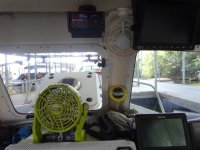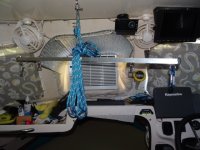KevinMc
Member
- Joined
- Sep 10, 2023
- Messages
- 36
- Reaction score
- 0
- C Dory Year
- 2006
- C Dory Model
- 23 Venture
- Vessel Name
- Sea~Dory~Able
Hi to all you Folks out there in Doryland,The weather is changing here in south Florida,I can now do some needed upgrades to Sea~Dory~Able.I was considering roof top A/C or the traditional water-cooled with through hull or a carry aboard.I did order a roof top unit but cancelled the order until I feel more comfortable with the options available.
I am concerned about the Roof top RV option due to righting moment and the extra 100+ Lbs so much above the waterline on an already tender boat.
I was also leaning (no Pun) toward the traditional water cooled marine A/C but finding the cabinet space is challenging what with the fresh water tank taking up most of the aft port side seating cabinet,which would be a perfect spot!There are some advanced new portables out there but still take up room and seem too tall to fit under the table,what to do?
I think the roof top option may be the best but all the reputable R/V units
(120Volts) may be too powerful at 9K btu and above for 104 Sqft / under 830Cuft. Any thoughts on the subject would be appreciated.KevinMc.P.s I saw Dr. Bobs' solution but will hold off on the roof hole for now.
I am concerned about the Roof top RV option due to righting moment and the extra 100+ Lbs so much above the waterline on an already tender boat.
I was also leaning (no Pun) toward the traditional water cooled marine A/C but finding the cabinet space is challenging what with the fresh water tank taking up most of the aft port side seating cabinet,which would be a perfect spot!There are some advanced new portables out there but still take up room and seem too tall to fit under the table,what to do?
I think the roof top option may be the best but all the reputable R/V units
(120Volts) may be too powerful at 9K btu and above for 104 Sqft / under 830Cuft. Any thoughts on the subject would be appreciated.KevinMc.P.s I saw Dr. Bobs' solution but will hold off on the roof hole for now.



